building a street rod with 5.0 ford fuel injection what elec.fuel pump to use
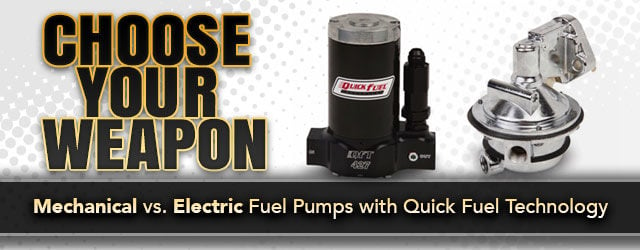
In simpler times, carburetors relied on mechanical fuel pumps, and EFI engines required high-pressure level electrical pumps. Things aren't and so elementary anymore considering times have definitely changed. Even the most beastly of electric pumps tin can struggle to continue stride with today's crop of 3,000-plus horsepower Outlaw and Pro Modernistic-fashion forced induction EFI engines.
At this level, belt-driven mechanical pumps are very much the norm. At the opposite end of the spectrum, the ascent of belatedly-model engine swaps has increased the popularity of electrical fuel pumps at modest horsepower levels more typically associated with mechanical pumps. In between these 2 extremes, a typical street/strip application can make exercise with either an electric or a mechanical pump. So which is correct for your motorcar?
Mechanical vs. Electric
Although mechanical and electric fuel pumps each have their share of pros and cons, sometimes information technology all comes down to practicality. "The obvious advantages of a mechanical pump are that they don't brand any noise and they don't require whatever additional plumbing or wiring. That'south a large plus," Zach Baker of Quick Fuel Applied science explains. "However, these days we're starting to come across people swap carbureted GM LS motors, Ford mod motors, and even late-model big-block Chevys into older musclecars. Since these engines were fuel injected from the factory, they never came with bosses to mountain a mechanical pump on the block. For these applications, QFT offers a line of pocket-sized electric fuel pumps that are very quiet, reliable, and street friendly."
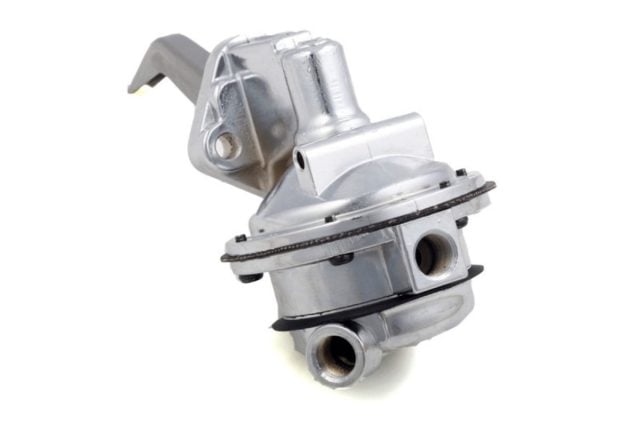
Available for minor- and large-cake Chevy, Ford and Chrysler engines, QFT's 110 GPH mechanical fuel pumps tin support up to 350 hp. Integrated shutoff valves set at 6.5-8 psi eliminate the need for a separate pressure regulator. QFT likewise offers 130 GPH units for small-block Chevys that are skilful for over 400 hp.
QFT's entry-level cast electric fuel pumps might be compact in size, merely they can support up to 750 horsepower. Across that level, QFT recommends stepping up to a high-capacity barracks electric pump. With menstruum ratings that range between 230- and 427 gallons per hour (GPH), QFT's Pro Series pumps can support 800-2,500 hp. Impressive flow rates aside, optimizing fuel pump performance and reliability requires matching the right pump with the right application.
"All of our electric pumps that catamenia 175 GPH or less are very street friendly," Baker adds. "Our Pro Series pumps are designed for very demanding drag racing applications. Street apply with these pumps should be very limited."
Since different hot rodders translate "very limited" in different ways, QFT has a simple slice of advice for those that similar to push the envelope. "These days it's not uncommon for people to brand over one,000 horsepower," says Bakery. "At that power level with 1 of our Pro Serial pumps, information technology's fine to bulldoze down to Sonic and grab a hamburger, merely you definitely don't want to drive across the country. Any of our pumps that menstruation 230-plus GPH are intended primarily for drag racing use."
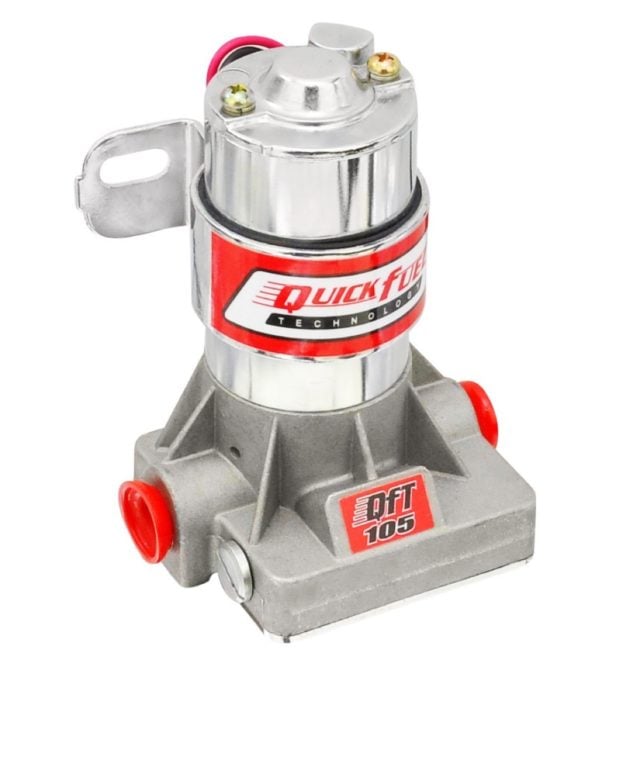
Perfect for GM LS and Ford modern motor swaps, QFT's bandage aluminum electrical pumps pack a lot of catamenia into a compact package. Available in 105-, 125-, and 155 GPH models, these units can support 350-700 hp. Mounting hardware is included, and they draw just four amps of current.
Enhancing Reliability
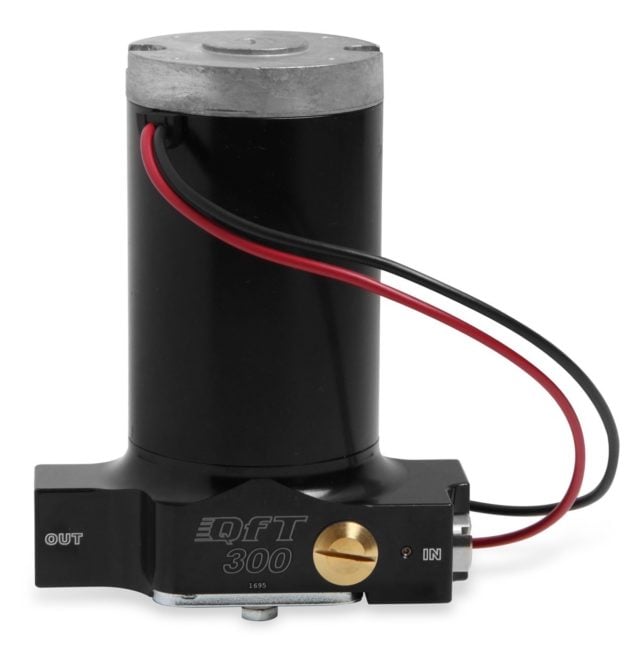
QFT Pro Series
The ultimate in drag racing immovability and performance, QFT'south Pro Serial barracks fuel pumps are offered in 230-, 260-, 300-, and 427 GPH models. Uniform with gasoline, alcohol and E85, these pumps can support 800-two,500 hp.
Even the best electric fuel pumps on the marketplace aren't very forgiving of poor installation practices. Fortunately, a little common sense goes a long fashion in maximizing pump reliability. "Trying to run a $400 pump off of a $2 toggle switch isn't going to work for very long. You always want to wire a pump through a relay," Baker advises. "Mount the pump close to the tank and lower than the fuel supply to ensure that information technology's gravity-fed properly. Too, brand sure to follow the manufacturer'south recommendation for fuel line sizing. Matching up a -12AN feed line with a -6AN render line isn't going to work very well. All of our Pro Series pumps have -10AN inlets and outlets."
Granted that the Pro Series' billet aluminum structure enhances durability on the outside, each and every internal component has also been optimized to ensure reliability on the inside. Pro Series pumps use a proven six-vane design as well as epoxy-coated windings to extend motor life. The pump base is integrated into the bottom of the motor to improve pump seal and shaft alignment, and an integrated bypass valve eliminates pump cavitation while stabilizing fuel menses.
Equally important is the design of the bones pumping mechanism itself. "Rotor and vane fashion pumps are very reliable and they have been around forever," says Baker. "We prefer using it over a gerotor blueprint considering if yous become a piece of sand or debris in a yard-rotor pump, it's done. The rotor and vane pumps that we use are impenetrable, and you could probably pump the water out of your basement with ane of them."
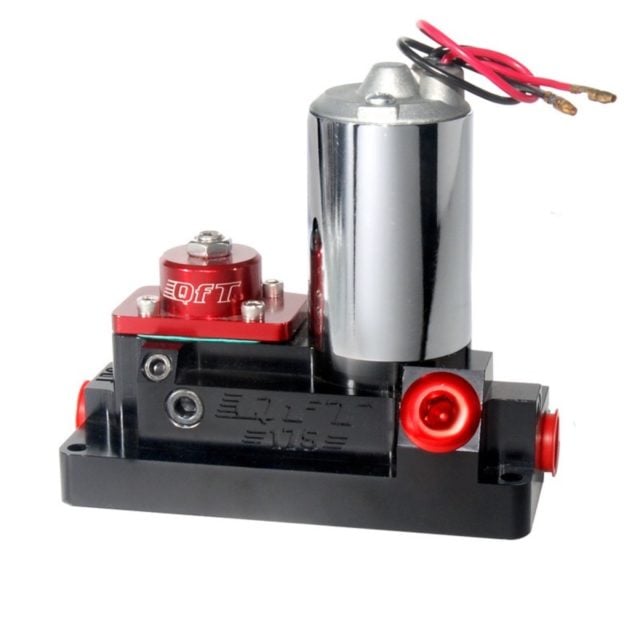
Although it looks like a race-just pump, QFT's barracks 175 GPH electric pump will run reliably on the street. It features an -8AN inlet and outlet, an integrated bypass pressure regulator, and a built-in pressure level gauge port.
Source: https://www.enginelabs.com/engine-tech/fuel-systems/mechanical-vs-electric-fuel-pumps/
0 Response to "building a street rod with 5.0 ford fuel injection what elec.fuel pump to use"
Post a Comment